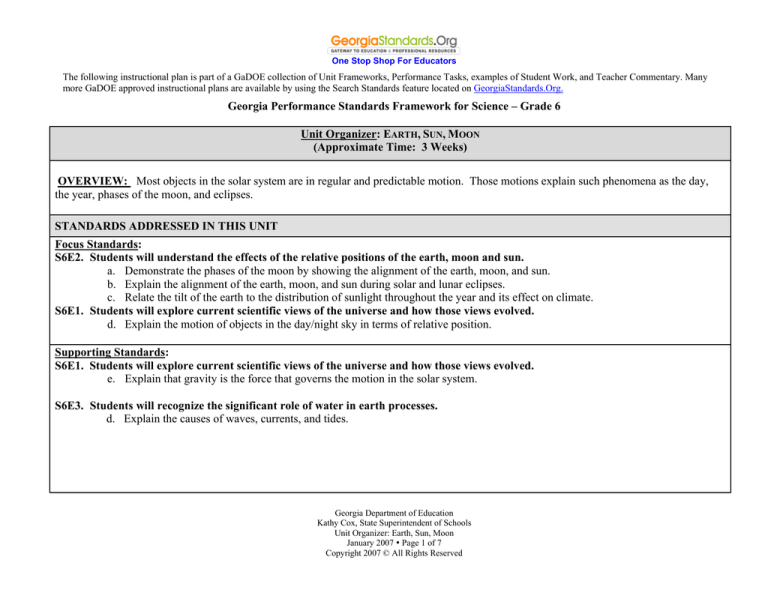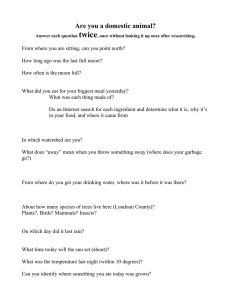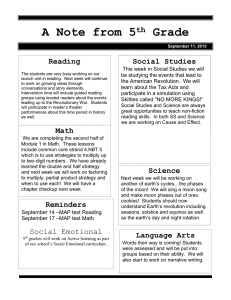
One Stop Shop For Educators
The following instructional plan is part of a GaDOE collection of Unit Frameworks, Performance Tasks, examples of Student Work, and Teacher Commentary. Many
more GaDOE approved instructional plans are available by using the Search Standards feature located on GeorgiaStandards.Org.
Georgia Performance Standards Framework for Science – Grade 6
Unit Organizer: EARTH, SUN, MOON
(Approximate Time: 3 Weeks)
OVERVIEW: Most objects in the solar system are in regular and predictable motion. Those motions explain such phenomena as the day,
the year, phases of the moon, and eclipses.
STANDARDS ADDRESSED IN THIS UNIT
Focus Standards:
S6E2. Students will understand the effects of the relative positions of the earth, moon and sun.
a. Demonstrate the phases of the moon by showing the alignment of the earth, moon, and sun.
b. Explain the alignment of the earth, moon, and sun during solar and lunar eclipses.
c. Relate the tilt of the earth to the distribution of sunlight throughout the year and its effect on climate.
S6E1. Students will explore current scientific views of the universe and how those views evolved.
d. Explain the motion of objects in the day/night sky in terms of relative position.
Supporting Standards:
S6E1. Students will explore current scientific views of the universe and how those views evolved.
e. Explain that gravity is the force that governs the motion in the solar system.
S6E3. Students will recognize the significant role of water in earth processes.
d. Explain the causes of waves, currents, and tides.
Georgia Department of Education
Kathy Cox, State Superintendent of Schools
Unit Organizer: Earth, Sun, Moon
January 2007 y Page 1 of 7
Copyright 2007 © All Rights Reserved
One Stop Shop For Educators
Georgia Performance Standards Framework for Science – Grade 6
ENDURING UNDERSTANDINGS
Students will understand that:
• The moon’s orbit around the Earth once in about 28 days changes what part of the moon is lighted by the sun and how much of that part
can be seen from the earth.
• A lunar eclipse occurs when the moon passes through theϖ Earth’s shadow.
• A solar eclipse occurs when the moon passes between theϖ Earth and the sun.
• Because the Earth turns daily on an axis that is tilted relative to the plane of the Earth’s yearly orbit around the sun, sunlight falls more
intensely on different parts of the Earth during the year. The difference in heating of the Earth’s surface produces the planet’s seasons and
weather patterns.
• The gravitational pull from the moon, and the spinning ofϖ the earth, causes ocean water to bulge, producing the tides.
ESSENTIAL QUESTIONS:
TOPICAL ESSENTIAL QUESTIONS
Why does the moon appear to change shapes?
How do lunar and solar eclipses differ? How are lunar and solar eclipses alike?
Why does the Earth have different seasons?
How does the gravitational pull of the moon affect me when I am at the beach?
Georgia Department of Education
Kathy Cox, State Superintendent of Schools
Unit Organizer: Earth, Sun, Moon
January 2007 y Page 2 of 7
Copyright 2007 © All Rights Reserved
One Stop Shop For Educators
Georgia Performance Standards Framework for Science – Grade 6
KNOWLEDGE:
The students will know…
• The Moon is about 400 times smaller than the Sun, but it also happens to be about 400 times closer. The result is that from Earth, they
appear to be the same size.
• When its orbit around Earth takes the Moon directly between Earth and the Sun, the Moon blocks our view of the Sun in what we call a
solar eclipse.
• The Moon changes in position in the sky each day. It also changes in appearance from a full Moon to a thin crescent. These changes are
called phases.
•
•
•
•
•
•
•
•
•
•
The Moon's light comes from the Sun, and the sunlight is reflected off the Moon's surface.
The phase of the Moon that we see depends on the orientation of the Earth and Moon, relative to the Sun.
Rotation is spinning on an axis.
Revolution is orbiting around another body.
The length of time from New Moon to New Moon is called the LUNAR MONTH or SYNODIC PERIOD of the Moon. It is 29.53 days.
The same side of the Moon always faces the Earth because the Moon turns on its axis at the same rate as it revolves around the Earth.
The Moon rises in the east and sets in the west daily, but its position in the sky moves EASTWARD by about 13 degrees per day.
The Moon rises and sets almost 1 hour later each night.
Waxing means to increase in size or grow larger.
Waning means to decrease in size or grow smaller.
• Lunar eclipses happen when the Moon passes through the Earth's shadow, whereas solar eclipses happen when the Earth passes through
the Moon's shadow.
• The gravitational pull of the Moon, and to a lesser degree the Sun, interacts with the rotation of the Earth and the shape of ocean basins to
produce the tides.
Georgia Department of Education
Kathy Cox, State Superintendent of Schools
Unit Organizer: Earth, Sun, Moon
January 2007 y Page 3 of 7
Copyright 2007 © All Rights Reserved
One Stop Shop For Educators
Georgia Performance Standards Framework for Science – Grade 6
CONCEPTS:
Relative motion, gravity, behavior of light
LANGUAGE:
alignment of moon, sun, and earth during phases of the moon, solar eclipse, lunar eclipse, tilt of earth, luminous, phases of moon
MISCONCEPTIONS
PROPER CONCEPTIONS
Seasons are caused by the Earth’s distance from the Sun.
The Sun and the Moon are the same size.
Seasons are caused by the change in the angle of the Sun's rays on
Earth due to the tilt of the Earth (hemisphere tilted towards the Sun
and away from the Sun).
The Sun is a much larger object than the moon.
You can't see the Moon during the day.
The moon can be seen during the day during several of the moon's
phases. The time and length of day that the moon can be seen varies
with the phase of the moon.
The Moon does not rotate.
The Moon does rotate on its axis. Its rotation period is the same as its
revolution period; therefore, the same side of the Moon is always
facing the Earth.
The back side of the Moon (the side away from Earth) is always dark.
The Sun's rays do strike the back side of the Moon. However, from
our position on Earth, we never see the light striking that side of the
Moon.
The Moon's phases are caused by the shadow of the Earth on the
Moon.
The Moon's phases are caused by the part of the Moon that reflects
the Sun and seen from our position on Earth.
Georgia Department of Education
Kathy Cox, State Superintendent of Schools
Unit Organizer: Earth, Sun, Moon
January 2007 y Page 4 of 7
Copyright 2007 © All Rights Reserved
One Stop Shop For Educators
Georgia Performance Standards Framework for Science – Grade 6
EVIDENCE OF LEARNING:
By the conclusion of this unit, students should be able to demonstrate the following competencies:
Culminating Activity:
Earth, Moon And Sun Culminating Activities
Goal - To make a presentation of information about the objects in the day/night sky, phases of the moon, solar and lunar eclipses, and
relationship between the tilt of the moon and climate
Role - Video game player and outstanding Earth Science student
Audience - Creators of video game
Situation - While playing a video game, you realize that the creators have made several errors based on your knowledge of Earth Science. You
have contacted the creators of the game and they have agreed to meet with you to hear more information about the inaccuracies in their game.
Product - You must make a presentation to them that will provide them with accurate information using the "Earth, Moon, and Sun Product
Rubric".
Georgia Department of Education
Kathy Cox, State Superintendent of Schools
Unit Organizer: Earth, Sun, Moon
January 2007 y Page 5 of 7
Copyright 2007 © All Rights Reserved
One Stop Shop For Educators
Georgia Performance Standards Framework for Science – Grade 6
Earth, Moon, and Sun Product Rubric
4
3
2
1
Phases of the Moon
Accurately and
thoroughly describes the
alignment of the Earth,
Moon, and Sun during
each phase of the Moon
Accurately describes the
alignment of the Earth,
Moon, and Sun during
each phase of the Moon,
but not very thorough
Accurately describes the
alignment of the Earth,
Moon, and Sun during
some of the phases of the
Moon, but does not
include information on all
of the phases of the Moon
Contains some
inaccuracies in the
alignment of the Earth,
Moon, and Sun during
some or all of the phases
of the Moon
Solar and Lunar Eclipses
Accurately and
thoroughly shows an
understanding of the
alignment of the Earth,
Moon, and Sun during
both solar and lunar
eclipses
Accurately shows an
understanding of the
alignment of the Earth,
Moon, and Sun during
both solar and lunar
eclipses, but not very
thorough
Accurately shows an
understanding of the
alignment of the Earth,
Moon, and Sun during
either a solar or lunar
eclipse, but not both
Contains some
inaccuracies in the
alignment of the Earth,
Moon, and Sun during
solar and/or lunar
eclipse(s)
Tilt of the Earth
Accurately and
thoroughly relates the tilt
of the Earth to the
distribution of sunlight
during the year and its
effect on climate
Accurately relates the tilt
of the Earth to the
distribution of sunlight
during the year and its
effect on climate, but not
very thorough
Accurately relates the tilt
of the Earth to either the
distribution of sunlight
throughout the year or its
effect on climate, but not
both
Contains some
inaccuracies in the
relationship between the
tilt of the Earth and the
distribution of sunlight
throughout the year and/or
its effect on climate
Comets, Asteroids, and
Meteors
Accurately and
thoroughly describes the
characteristics of comets,
asteroids, and meteors
Accurately describes the
characteristics of comets,
asteroids, and meteors,
but not very thorough
Accurately describes the
characteristics of either
comets, asteroids, or
meteors, but not all three
Contains some
inaccuracies in the
descriptions of comets,
asteroids, and/or meteors
Georgia Department of Education
Kathy Cox, State Superintendent of Schools
Unit Organizer: Earth, Sun, Moon
January 2007 y Page 6 of 7
Copyright 2007 © All Rights Reserved
One Stop Shop For Educators
Georgia Performance Standards Framework for Science – Grade 6
TASKS
The collection of the following tasks represents the level of depth, rigor and complexity expected of all physical science students to
demonstrate evidence of learning.
Task:
Description:
Discussion, Suggestions for use:
Possible Solution :
SAMPLE OF STUDENT WORK
Georgia Department of Education
Kathy Cox, State Superintendent of Schools
Unit Organizer: Earth, Sun, Moon
January 2007 y Page 7 of 7
Copyright 2007 © All Rights Reserved




